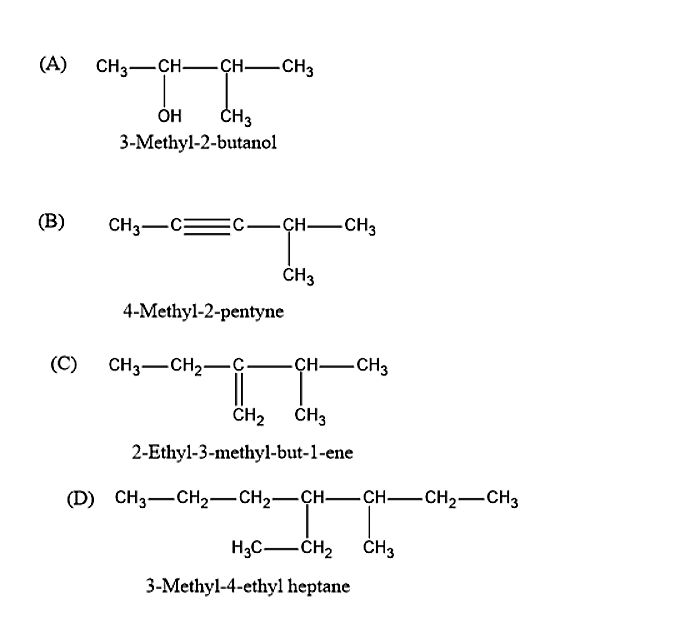
Name of some compounds are given. Which one is not correct in the IUPAC system?


Answer
427.5k+ views
Hint: In order to find which name is not in the IUPAC system, we must first know what an IUPAC system is and what are the different rules for naming the organic compounds. IUPAC is abbreviated as International Union of Pure and Applied Chemistry. This system is useful for naming the organic compounds in a systematic way.
Complete answer:
Let us first understand about the IUPAC nomenclature. IUPAC nomenclature is the systematic way of naming the organic compounds. IUPAC is abbreviated as the International Union of Pure and Applied Chemistry.
Now let us see what are the different rules or steps for naming the organic compounds.
- we have to first identify the longest chain, i.e., the parent compound must be identified.
- The Carbon atom in the parent hydrocarbon must be numbered using the natural numbers. Beginning from that end where the carbon atom which is having the substituent can be given the lowest number.
- When there are many numbers of the same substituent in the given organic compound, then it will be given with a prefix such as di, tri, etc.
- When there are multiple substituents in the same compound, then the substituents are arranged according to the alphabetical order.
- When there are two substituents on the same position of the carbon atom, then these substituents are arranged in the alphabetical order.
From the above given rules, we can say that the option (D) is not in the correct IUPAC system, because there are more substituents in the given organic compound and these substituents are not arranged in the alphabetical order.
The option (D) can be correctly written in the IUPAC system as 4-Ethyl-3-methyl heptane.
Hence the correct answer is option (D).
Note:
We have to remember that there are different IUPAC nomenclature methods such as:
- Compositional nomenclature
- Substitutive nomenclature
- Additive nomenclature
Complete answer:
Let us first understand about the IUPAC nomenclature. IUPAC nomenclature is the systematic way of naming the organic compounds. IUPAC is abbreviated as the International Union of Pure and Applied Chemistry.
Now let us see what are the different rules or steps for naming the organic compounds.
- we have to first identify the longest chain, i.e., the parent compound must be identified.
- The Carbon atom in the parent hydrocarbon must be numbered using the natural numbers. Beginning from that end where the carbon atom which is having the substituent can be given the lowest number.
- When there are many numbers of the same substituent in the given organic compound, then it will be given with a prefix such as di, tri, etc.
- When there are multiple substituents in the same compound, then the substituents are arranged according to the alphabetical order.
- When there are two substituents on the same position of the carbon atom, then these substituents are arranged in the alphabetical order.
From the above given rules, we can say that the option (D) is not in the correct IUPAC system, because there are more substituents in the given organic compound and these substituents are not arranged in the alphabetical order.
The option (D) can be correctly written in the IUPAC system as 4-Ethyl-3-methyl heptane.
Hence the correct answer is option (D).
Note:
We have to remember that there are different IUPAC nomenclature methods such as:
- Compositional nomenclature
- Substitutive nomenclature
- Additive nomenclature
Recently Updated Pages
Class 11 Question and Answer - Your Ultimate Solutions Guide

Master Class 11 Business Studies: Engaging Questions & Answers for Success

Master Class 11 Accountancy: Engaging Questions & Answers for Success

Master Class 11 Social Science: Engaging Questions & Answers for Success

Master Class 11 Physics: Engaging Questions & Answers for Success

Master Class 11 Maths: Engaging Questions & Answers for Success

Trending doubts
The reservoir of dam is called Govind Sagar A Jayakwadi class 11 social science CBSE

What problem did Carter face when he reached the mummy class 11 english CBSE

Proton was discovered by A Thomson B Rutherford C Chadwick class 11 chemistry CBSE

Petromyzon belongs to class A Osteichthyes B Chondrichthyes class 11 biology CBSE

Comparative account of the alimentary canal and digestive class 11 biology CBSE

Lassaignes test for the detection of nitrogen will class 11 chemistry CBSE




